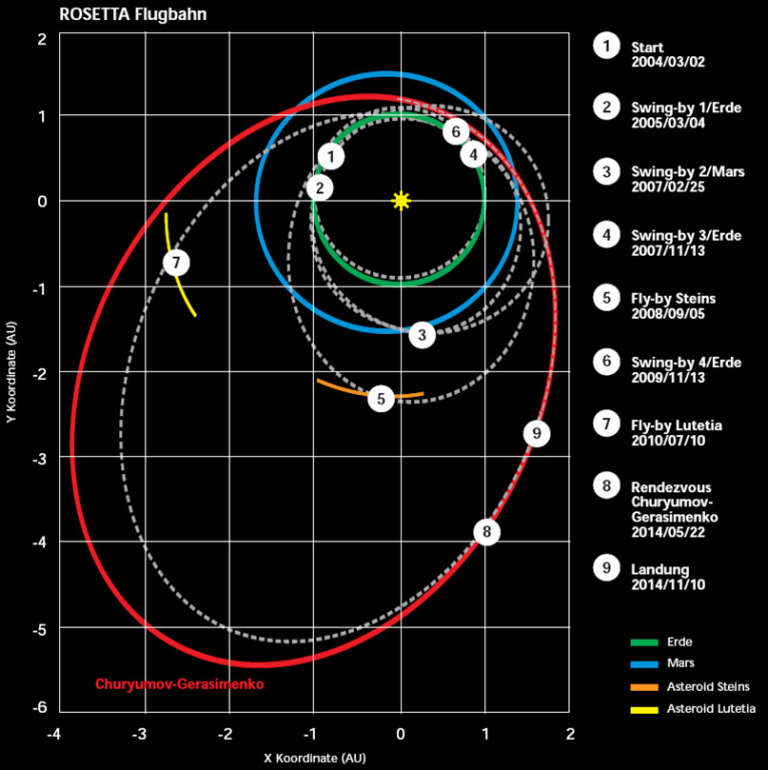Emily Lakdawalla • Feb 22, 2011
Rosetta Update: 98% of rendezvous burn achieved, more detail on the safing event
ESA's Rosetta comet chaser has achieved 98% of the velocity change that it needed to accomplish in order to set itself up for the final leg of its cruise to comet Churyumov-Gerasimenko. The original plan was to perform this velocity change in a series of five rocket burns at the end of January, but the plans were interrupted by a scary event: the spacecraft went into safe mode during the second burn, on January 18. At last there is an explanation of what happened on ESA's website. It was in audio format, from spacecraft operations manager Andrea Accomazzo, so I transcribed the key parts of it below.
On the night of the 18th of January we were supposed to do the second burn of the big rendezvous maneuver, which is normally split in five burns. An hour into this burn, anomalous behavior of the spacecraft triggered a safe mode. The spacecraft detected a problem with the attitude, this behavior interrupted the burn and performed a transition to a mode which is considered safe, reacquired the earth pointing attitude, and was waiting for us. This problem was mainly given by a misbehavior of the thrusters of the spacecraft that led the attitude of the spacecraft to tilt slightly, by about two degrees, so it's a very minimal deviation of the attitude compared with the commanded one. Nevertheless, such a deviation is considered a large one, and interrupted the burn.
The safe mode triggered a reconfiguration of the propulsion system of the spacecraft so when we came back from the safe mode we were using the redundant set of thrusters and propulsion system. We were puzzled by this event, of course, and we started an investigation of what occurred. In a very short time we could actually figure out what was triggering this misbehavior of the spacecraft, even though we don't understand even yet exactly why this happens, we know what was happening and we thought immediately of a way of avoiding this problem.
This was one of the few times in the mission we were using the redundant branch of the propulsion system so before further activities we decided to do some test activities in general on the redundant branch of the thrusters and these were all successful. And then what we did was design a maneuver which was contributing to the overall rendezvous maneuver but which was to be considered as a test of a new operating mode of the reaction control system. We commanded the spacecraft to use the thrusters in a slightly different way from what we did for the first two burns, because we suspected the source of the problem was in that area, and indeed when we did this test maneuver the spacecraft behavior was much much better than what it had been during the previous two slots. So with this achievement we decided then to continue the rest of the maneuver.
The safe mode occurred on the 18th of January on the night. We did this test maneuver in the night of the 21st of January. We had already prepared before this test maneuver also all the commands to continue the burn maneuver, then in the first sequence we did another three burns on the 22nd, 23rd, and 24th of January. So with one day delay compared to the nominal schedule we completed the burns required for the delta-vee maneuver. In total, what we have already done so far is 98% of the rendezvous maneuver. Tonight we do the last 2%.
These maneuvers are one of the two maneuvers that we need to reach and meet the comet. With this maneuver we have done an increase of the velocity of the spacecraft of 800 meters per second. With the second one which will be done in 2014 we will do a similar change of velocity. With this maneuver we are already on a collision course with the comet. With the next maneuver we will further tune the trajectory such that we will not be any more on a collision course, we will be on a course that leads us to the comet, and leads us to match exactly the same velocity of the comet, such that we can follow its orbit around the Sun.It's good to hear reassurance that the spacecraft is on the desired course and that it's behaving properly again, though a bit disquieting that they're still not sure exactly what the source of the "misbehavior" was.
There were few more interesting tidbits in the audio update. In June of this year, its increasing distance from the Sun will cause Rosetta's solar panels to provide less power than is needed to keep the spacecraft active, so they are planning for the spacecraft to hibernate from June 2011 to January 2014. There will be no contact from the spacecraft at all during this period; it must awaken itself at the end of its hibernation period. They're now buttoning up the spacecraft, doing some final tests on the power system to understand its performance at 4 astronomical units (600 million kilometers) from the Sun, since it'll be at about the same distance and in a very critical power and thermal situation when it wakes up in 2014. Before going into hibernation, Rosetta will first pass through solar conjunction, in April and May. As there was with the Mars spacecraft during that planet's recent conjunction, there will be a command moratorium for Rosetta during this time; the mission will wait until after conjunction to give the final commands to the spacecraft to place it into hibernation mode.

The Time is Now.
As a Planetary Defender, you’re part of our mission to decrease the risk of Earth being hit by an asteroid or comet.
Donate Today

 Explore Worlds
Explore Worlds Find Life
Find Life Defend Earth
Defend Earth

